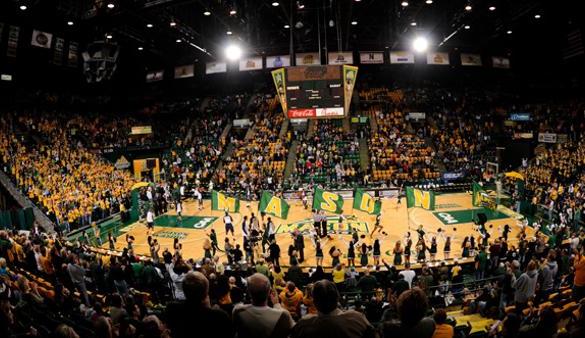Report: GMU men's basketball had shortfall of $2.3 million in '11-'12
On Monday morning, the Joint Legislative Audit and Review Commission released a report detailing non-academic services and costs of higher education public institutions in Virginia.
The report addressed a number of issues facing the current landscape of college athletics, specifically in the state, including funding, student fees and revenue generation of basketball and football programs.
Of the 15 Virginia public institutions studied, four of them generated over 40 percent of the required revenue to operate the athletic program. Virginia Tech (89 percent) and Virginia (84 percent) led the pack while Old Dominion University (26 percent), Virginia Commonwealth University (24 percent), George Mason University and James Madison University (21 percent each) rounded out the group under 50 percent.
Student fees are a main source of funding for athletic programs, accounting for $160 million in Virginia public institutions in 2011-2012 alone. Without revenue from mandatory athletic-related fees, athletic programs could not support themselves with the day-to-day operations of each program. However, each institution is faced with a different situation as far as reliance on these fees goes.
According to the report, in 2011-2012, Mason used $13.4 million of the state’s $160 million total athletic fees income to fund the athletic department, equating to 67 percent of the school's total athletic revenue. Va. Tech relies on 10 percent of student fee revenue, while Radford University pours 88 percent of their student fee revenue into athletics.
In Virginia, the average mandatory athletic-related fee per year is around $1,185, across the 15 public institutions. Mason had the second-lowest mandatory athletic-related fee in the state ($577 per year), just behind Va. Tech with a mere $267 of fees annually. The average percentage of in-state tuition and fees distributed for athletics amongst the state reached 12 percent; Mason used six percent of the tuition and fees to support the athletic department.
With the rising costs to fund college athletics over the past six years, the demand for increased revenue streams has become a vital commodity for athletic programs across the state and the country. Old Dominion University, with the reinstatement of football in 2009, saw the student fees double from $641 in 2004-2005 to $1,185 in 2011-2012.
To make matters worse, only two Virginia schools (UVa. and Va. Tech) turned a profit on both their basketball and football programs in 2011-2012. UVa. drove in a combined $5.7 million in revenue from the sports, while Va. Tech raised a surplus of $18.9 million with over $13 million generated from football.
Schools like Mason, JMU and VCU have struggled to bring in revenue for men’s basketball, each taking over $1 million shortfalls after dealing with the high level of expenditures. Mason managed to raise only $683,000 despite facing $3 million expenditures, taking a $2.3 million shortfall in 2011-2012. VCU, amid a magical run to the 2011 Final Four, raised $1 million in revenue and yet, still had a shortfall of $3 million with over $4 million in expenditures.
The JLARC is an independent, watchdog agency whose goal, according to their website, is to “evaluate the operations and performance of State agencies and other programs.”


